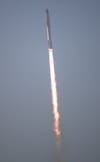Strategic Overview - Revolution America: MAGA is Pro-Growth not Libertarian - July 8, 2025
Join Kesha Rogers and Michael Steger in an illuminating discussion on the latest political developments. They cover President Trump’s
The amazingly successful fourth flight test of the SpaceX Starship/Superheavy and the successful first delivery of astronauts to the International Space Station by Boeing's Starliner offer humanity a bright future.

by Michael James Carr
June 6, 2024 was a very rough day for the Luddites and Dark Agers who spew pessimism liberally across all communications and mind-bending channels. On that day, SpaceX crested the steep hill of Starship/Superheavy development. By successfully demonstrating the soft landing of both the Superheavy booster and the Starship deep space vehicle, SpaceX proved that they certainly can achieve the dream of a fully reusable heavy lift capability to deep space.
Starship reentering like a meteor pic.twitter.com/YjfVIHLLCl
— Elon Musk (@elonmusk) June 6, 2024
Think of what happened to air travel with the introduction of the Boeing 747. Before that, air travel (especially intercontinental air travel) was rare and expensive. Those who could fly were known as the “Jet Set.” With the introduction of the first jumbo jet, and later with the advent of massively improved engine technology, air travel (even across oceans) became relatively commonplace and affordable for common people. The same process is now developing in space.
Or, think of the consequences of the introduction of the Ford Model T. Automobiles had been in existence for some time, but only wealthy people could afford to play with automotive toys. After the introduction of the Model T, a radical change in the lives of people and the economic geography of the world developed.
Since this 4th flight test of the Starship/Superheavy combination successfully demonstrated controlled landings for both components, the pace of testing will be able to pick up speed, as mishap investigations will not be required. SpaceX has been expanding its Starfactory with the aim of producing a couple complete systems per month. And SpaceX President, Gwynne Shotwell, has said that she expects to fly a couple of hundred flights before putting people aboard the system.
This progress is immediately important for implementing President Trump’s Artemis Project. A Starship derivative is contracted to land astronauts on the Moon in Artemis III. While much refinement is still required, SpaceX has proven that it will deliver.
On the same day, June 6th, the Boeing Starliner delivered its first crew of astronauts to the International Space Station. There is also much to be accomplished before the Starliner system can be certified as a taxi service to Low Earth Orbit, but that process should be complete within a year.
So, by the first year of President Trump’s second term, we should have 2 completely independent, lower cost systems, the SpaceX Dragon system and the Boeing Starliner system, for delivering astronauts to space stations in Earth orbit. These systems, plus the Starship heavy lift capability will facilitate the establishment of many orbiting space stations which will serve specialized functions.
Besides the Chinese Tiangong space station and the International Space Station, Axiom’s station, Blue Origin/Sierra Space’s Orbital Reef station, a new Russian station, and Voyager Space’s Starlab, and NASA’s Lunar Gateway are under development. Then there will be bases on the Moon, and later Mars.
We live in exciting times!
For a beautiful recap of the Starship/Superheavy flight test I recommend watching Scott Manley’s video:
For a rundown of the Starship/Superheavy 4th flight test’s accomplishments, visit:

Get our free newsletter. Zero Spam.